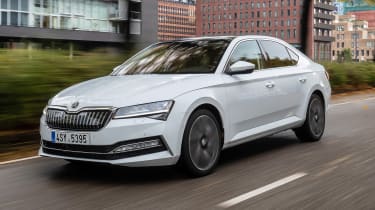Skoda Superb hatchback - Engines, drive & performance (2015-2024)
The Skoda Superb unashamedly places emphasis on comfort over a sporty drive
The Skoda Superb is intended to offer the feeling of a big executive saloon, like the Mercedes-Benz S-Class, in a smaller, more accessible car. It succeeds, but the result is a car which is focussed far more on comfort than on outright performance.
Whichever roads you take the Superb on, you’ll be immediately impressed by how smooth and hushed it is. The quietest engines of all are those fuelled by petrol and they really do make the car tremendously relaxing over long distances.
That doesn’t mean the diesels are below-par, though; they make competent motorway cruisers too. We prefer the 2.0-litre diesel engine; the bigger engine is more suitable for such a large car, delivering effortless acceleration and a more relaxed driving experience.
The versions equipped with four-wheel drive offer enhanced grip on wet or slippery surfaces, but the standard front-wheel-drive setup feels just as safe and secure when the weather isn’t at its worst.
If you’re in search of extra driving fun you might be interested to try the optional adaptive dampers. For an extra £715 (SE L) or £1,050 (Sportline Plus) you can set the suspension in either normal, comfort or sport modes. The comfort mode is great on motorways, allowing the car to glide serenely over bumps and potholes, but isn’t quite at home on a winding road, where its soft setup leads to a wallowy, imprecise feel in corners.
More reviews
In contrast, Sport mode achieves the opposite; tidy handling but a slightly harsh ride over surface imperfections, made worse if the car has the 18-inch alloy wheels fitted to top-of-the-range models. The best compromise is found in Normal mode.
The manual gearbox is easy to use, but the DSG automatic is such a sophisticated, efficient system that we recommend it if your budget allows. It certainly matches the Skoda Superb’s very relaxed character.
Skoda Superb diesel engines
None of the diesels give much in the way of the horrible clatter that used to be a failing of this type of engine in the past. They thrum unobtrusively under the bonnet and offer a good helping of punch when you need it, for example when overtaking or joining motorways.
The 148bhp 2.0-litre diesel strikes a great balance between performance and economy. It makes driving the Superb an effortless experience. There’s also a 197bhp version of the same engine, which only comes with the DSG automatic gearbox and goes from 0-62mph in eight seconds.
Petrol engines
Lower mileage drivers might be wise to look at the even quieter petrol engine. Our favourite is the 148bhp version of the 1.5-litre TSI, which returns good economy and low CO2 emissions thanks to its cylinder-deactivation technology.
It also has plenty of power when you need it so the Superb can make good progress even when laden with passengers and luggage – staying very quiet as it does so. This will be an attractive choice thanks to a reasonable Benefit-in-Kind (BiK) tax rating, although it’s worth paying attention to the wheel size, as this affects CO2 emissions and thus the exact BiK band.
Appealing for completely different reasons is the very quick 268bhp version of the 2.0-litre petrol engine, which accelerates extremely rapidly (0-62mph takes just 5.6 seconds) and offers a huge surge of power whenever you need it. It’s not the nicest sounding of engines but quietens down nicely when you reach cruising speed, which doesn’t take long.
It’s only available with the four-wheel drive system and the DSG automatic gearbox and, in truth, seems slightly ill-suited to the Superb’s relaxing temperament. Its high running costs will put a lot of potential buyers off, too. But we can see the appeal of all the power.
Hybrid engines
While it's the eco choice, the combination of the plug-in hybrid Superb iV's 1.4-litre turbocharged petrol engine and electric motor adds up to an impressive 215bhp, giving it a decent turn of speed. Acceleration from 0-62mph takes just 7.7 seconds, but in reality the iV doesn't feel at its best when driven hard. A more relaxed approach is best, letting the instant torque of the electric motor give the petrol a helping hand in hybrid mode. Electric propulsion alone can keep up with traffic in most situations, but battery power quickly depletes at motorway speeds where it's better for the petrol engine to do more of the work.















